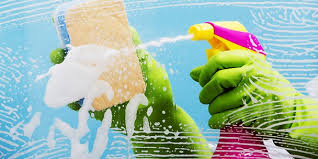The Essentials of Window Cleaning
Cleaning residential windows is a fairly simple chore because these are usually easy to reach, and not numerous, such as the case with single storied homes. Unlike commercial buildings that are often multi-storied, windows are hard to reach and typically abundant. Even small offices may not have many windows, but these may be hard to reach and dangerous to clean on the outside, especially without the right safety gear, training, and cleaning equipment.

The 5 Essential Items for Cleaning Windows
Whether you are a professional window cleaner or a home owner looking to keep up on cleaning your windows yourself, there are many tools available to make that job easier.
Here we will touch on the five most important items.
- Bucket
The window cleaning bucket serves two purposes:
- Holding soap while you are cleaning windows.
- Storing your window cleaning tools when they are not in use.
Window cleaning buckets are usually rectangular, and this is to better fit the entire length of your washer so you can get soap on the entire length all at once.
Standard buckets are about 6 gallons and easily work with washers and squeegees up to 18 inches in length. Smaller buckets are available, and may be more economical and space-saving if you are only working with smaller sized tools.
There are also round buckets and buckets on a belt. Round buckets are the preferred style for some window cleaners, they are also more readily available if you are just looking for something around your house to use. Buckets on a belt hang from a tool belt. They are designed to hold soap and both a washer and a squeegee, making them a more mobile choice.
- Soap
This is the liquid used to clean the window, and is very important.
Whether you use a solution from around the house (dish soap actually works very well for cleaning windows with a washer and squeegee) or a store-bought window soap, make sure you pay attention to your soap-to-water ratio.
More is not always better!
Too little soap will be more likely to dry quickly on the window and will lower the cleaning power of your solution. But too much soap can cause an over abundance of suds and leave streaks behind on the window.
A graduated dispenser that pre-measures can help with mixing your soap and keeping it consistent.
- Washer
A washer is composed of a fabric sleeve and a t-bar. This is the tool that scrubs the dirt off the window, with the help of your soap solution.
Washers come in a wide variety of styles. Some are regular fabric, some are microfiber. Some have extra scrubbing ability. Whichever type you use, it is important to wet and scrub the entire window, and keep it wet for the squeegee to remove.
The washer t-bars are available in solid handles or swivel handles, depending on your need and preference.
- Squeegee
The squeegee is the most important piece of the window cleaning arsenal. With it, you remove all of the dirty water. This leaves behind clean, dry, sparkling windows!
Technique is an important part of squeegeeing a window clean, and can take some practice.
Squeegees are made up of two parts – the squeegee channel and the squeegee handle – and they come in a wide variety too.
Channels come in a few different styles:
- brass
- stainless steel
- aluminum
- wide aluminum
Handles also come in a variety of different types:
- solid
- swivel
- ergonomic
- zero-degree
Choosing the right combination really comes down to preference and your needs.
- Towel
The towel is helpful to touch-up any wet spots left behind after squeegeeing, particularly around the edges and on the window sill.
Drip marks are the last thing you want after all of your hard work!
There are a great deal of different types of towels available, and these include:
- terry cloth towels
- microfiber towels
- re-purposed surgical or Huck towels
- scrim towels
- chamois

Handy Hint
If you’re a rookie, it is very important that you read our article on how to safely use a scraper on glass. It’s easy to damage glass with bad scraper technique but with some simple steps you can avoid all that pain.
Cleaning glass is as easy as 1, 2, 3
- Solution
Make a window cleaning solution by adding a small amount of Squeegee Wash detergent concentrate to a window cleaning bucket half filled with water. The solution should just feel a little slippery to touch.
- Scrub
First dip the window washer into the window bucket solution then squeeze out the excess liquid so the washer won’t drip. Wash the window with a circular motion. Ensure you do not over wet the window. Try to keep the frames as dry as possible, this makes the whole job easier. Before you use a washer for the first time it’s best to machine wash it first.
- Squeegee
Start by creating a dry zone. You do this by cutting the edge. That means creating a thin dry border down the left frame and across the top frame. Place the dry squeegee on the dry cut edge then squeegee across with very little pressure keeping the angle of the squeegee consistent. Dry the squeegee before placing it again on the glass.

Cleaning Windows with Vinegar Without Streaks
Vinegar is a miracle from nature. Completely non-toxic and anti-bacterial, vinegar is actually beneficial to any surface it touches. It safely kills germs and is much more economical than chemical cleaning solutions. It’s not even harmful when accidentally inhaled or ingested. (If you’ve got kids, you’ll love that part).
The acidic composition of vinegar acts quickly to break down the kind of film that frequently accumulates on glass surfaces. When you wash a window using a solution that contains vinegar, the results will almost always be free from streaks and sparkling clean.
Additional Tips
- When using water for cleaning glass, prefer to use distilled water instead of tap water, even for diluting the cleaning solution. The minerals present in regular water can leave behind streaks in spite of the use of the proper tools and all the elbow grease.
- In case there are stubborn streaks or hard water stains on the glass, you may use pure white vinegar without diluting it.
- While cleaning, make sure you wipe and dry the cleaner on the glass quickly to avoid streaks. Plus, it is recommended to dry the inside of the window in one direction and the outside in another. For instance, you can dry the inside with vertical strokes and the outside with horizontal strokes to make it easier for you to find the streaks.
- Windows should be cleaned thoroughly from the inside as well as outside every few months or at least, twice a year.
- For stained glass, the Stained Glass Association of America recommends minimal cleaning. It just needs light dusting on a regular basis. If there is a buildup of dirt and grime, then rub it with a cloth soaked in distilled water to avoid discoloration.